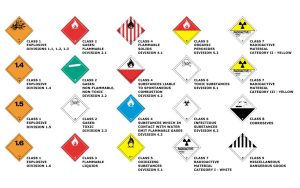While some dangerous goods are too dangerous for transport by air except under very detailed allowance by the civil aviation authority, many can only be transported on cargo-only aircraft, and others can be transported on both cargo and passenger aircraft. No matter which type of aircraft the dangerous goods are shipped on, there are always
specific requirements that must be followed.
When considering limitations for shipping dangerous goods it is never acceptable to ship any substance that is likely to "explode, dangerously react, produce a flame or dangerous evolution of heat or dangerous emission of toxic, corrosive or flammable gases or vapours under conditions normally encountered in transport must not be
carried on aircraft under any circumstance," per the IATA DGR.
There are still many other materials that may only be carried under very particular circumstances. These are considered "Dangerous Goods Forbidden Unless Exempted." Other everyday items may not seem outwardly dangerous but need to be checked for hazardous components, such as battery-powered devices, breathing apparatus, and dental apparatus. This is why it is important that passenger check-in, cargo reservation, sales, and passenger reservation staff all be provided with appropriate information so that they are well-informed and well-trained on what are dangerous goods.
Classification of dangerous goods Dangerous goods are grouped into nine classes:
Class 1-Explosives
Class 2-Gasses
Class 3-Flammable Liquids
Class 4-Flammable Solids; Substance Liable to Spontaneous Combustion;
Substances which, in Contact with Water, Emit Flammable Gases
Class 5-Oxidizing Substances and Organic Peroxides
Class 6-Toxic and Infectious Substances
Class 7-Radioactive Material
Class 8-Corrosives
Class 9-Miscellaneous Dangerous Substances and Articles, Including
Environmentally Hazardous Substances Several classes are separated into sub-divisions due to the wide scope of the hazards within the class

Identification of dangerous goods
Dangerous goods are assigned to UN numbers and proper shipping names according to their hazard classification and their composition. The identification of dangerous goods is essential for the proper packing and packaging, documentation, acceptance and handling. The IATA DGR lists approximately 3,000 substances and articles commonly shipped by air. Other dangerous goods publications
Recognizing that there is a degree of segmentation in the shipper community, where there are large numbers of shippers that only ship lithium batteries or devices powered by lithium batteries and the biomedical industry that only ship infectious substances,IATA developed separate manuals to address these commodities

